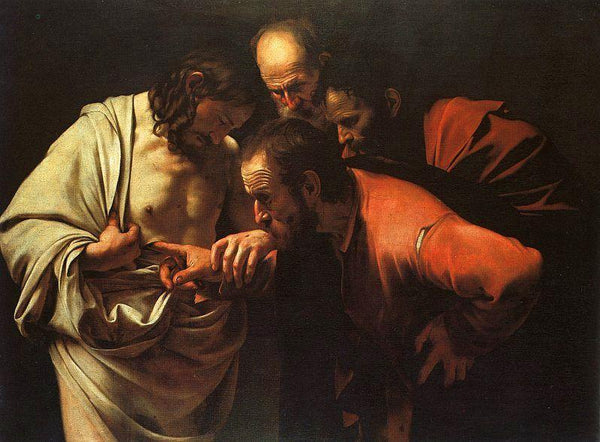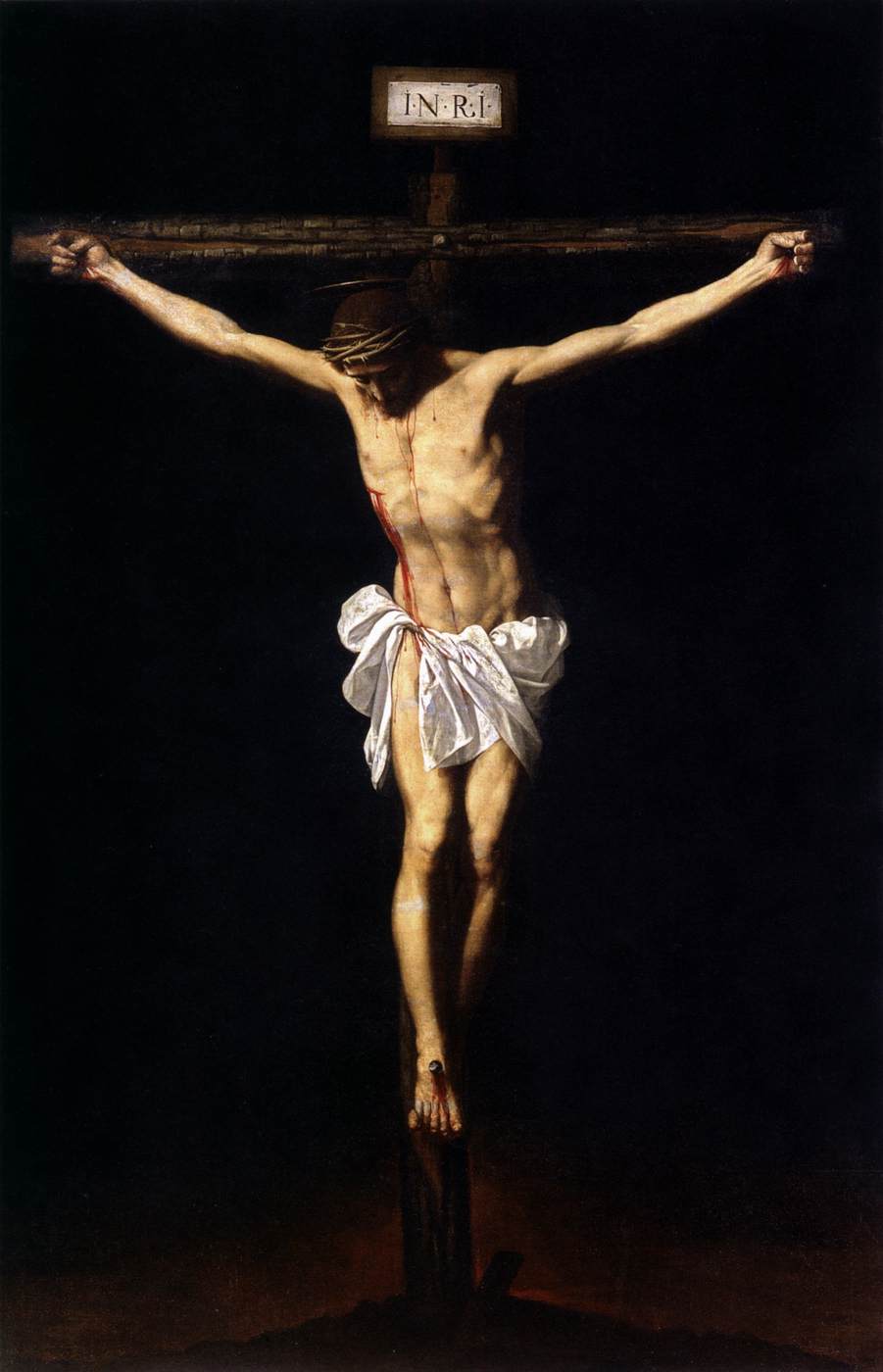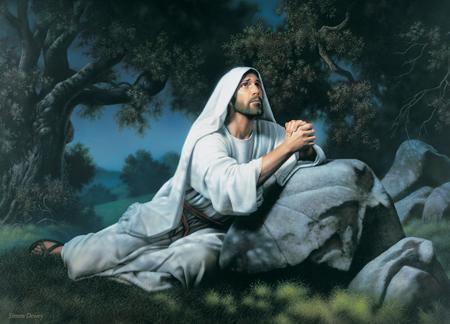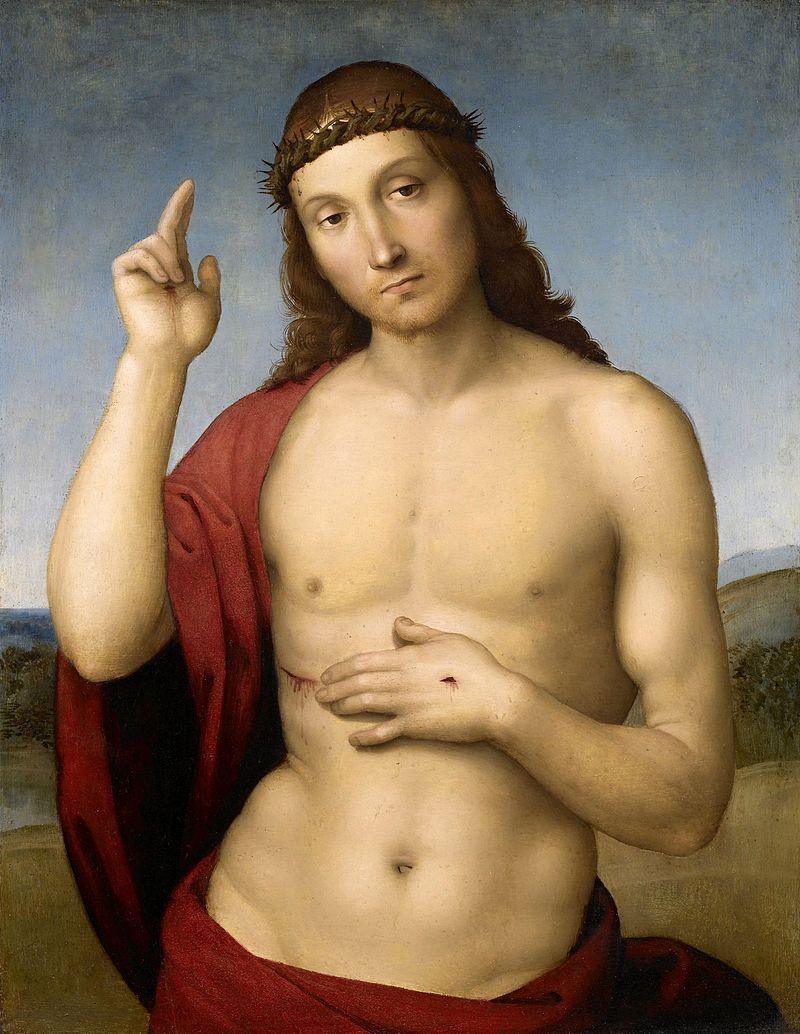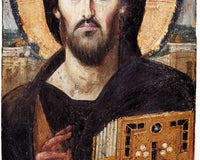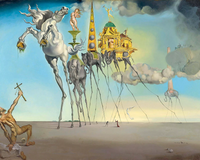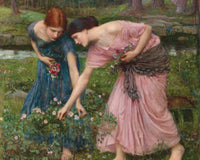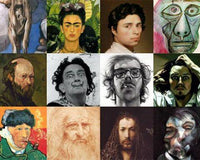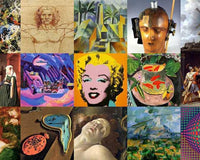Who was exactly the painter Caravaggio?
Caravaggio was an Italian Baroque painter considered one of the great masters of form. He was born Michelangelo Merisi in 1571 in the city of Caravaggio, near Milan. His father was a house steward and architect for the Marquis of Caravaggio, and his mother came from a family in the same profession. Caravaggio initially trained as a painter in Milan but soon moved to Rome, where he became known for his realistic style, which emphasized the emotional and dramatic aspects of his subjects. He often depicted religious scenes and used intense lighting and dark shadows to create a sense of tension and drama. Caravaggio’s work was highly influential and is known for masterpieces such as "The Calling of Saint Matthew" and "The Entombment of Christ". However, his life was also marked by controversy, and he was involved in several violent incidents. He died in 1610 at the age of 38.

The Calling of Saint Matthew
How did Caravaggio differ from other painters?
Caravaggio differed from many of his contemporaries in that he favored a more realistic painting style that emphasized the emotional and dramatic aspects of his subjects. This contrasted with the more formal and idealized style that was popular at the time. He also used intense lighting and dark shadows to create a sense of tension and drama, something that was not commonly seen in art at the time. Additionally, Caravaggio's use of ordinary people as models for his religious and mythological scenes was innovative and had a profound influence on the development of Western art. Overall, Caravaggio's unique style and approach to painting distinguish him from other artists of his time.
Is Caravaggio considered a master and in what way?
Caravaggio is considered one of the great masters of Baroque painting. The Baroque was a period in European art that began in the late 16th century and was characterized by elaborate, dramatic, and emotive works. Caravaggio was one of the leading practitioners of this style, and his work had a profound influence on the development of Western art. "The Calling of Saint Matthew" and "The Entombment of Christ" are considered among the best paintings of the Baroque era. His realistic approach to painting, his use of intense lighting and dark shadows, and his representation of religious and mythological scenes in a new and innovative way contributed to his reputation as a master painter.

The Entombment of Christ - Caravaggio's most famous work
What artistic characteristics distinguished Caravaggio?
Caravaggio was known for his realistic painting style, which emphasized the emotional and dramatic aspects of his subjects. He often used common people as models for his religious and mythological scenes, something that was not commonly seen in art at the time. Additionally, Caravaggio was known for his use of intense lighting and dark shadows to create a sense of tension and drama, which was a key characteristic of his work. This technique, known as chiaroscuro, involved using strong contrasts between light and dark to create a sense of depth and movement in the painting. Caravaggio's innovative use of this technique had a profound influence on the development of Western art. Overall, his realistic style, use of common people as models, and innovative use of chiaroscuro were the key artistic characteristics that distinguished him from other painters of his time.
Is it difficult to emulate the technique used by Caravaggio?
Although Caravaggio's technique is highly valued and admired, it is not necessarily difficult to emulate. Like any other painting technique, it can be learned and mastered through practice and study. The key to Caravaggio's technique was his use of intense lighting and dark shadows to create a sense of drama and movement in his paintings. This involved the careful placement of light and dark areas in the painting to create a sense of depth and draw the viewer's attention to the key elements of the scene. While mastering this technique requires skill and practice, it is not necessarily more difficult to learn than other painting techniques.
Was Caravaggio a genius with problems?
Whether Caravaggio was a "genius with problems" is a subjective judgment that would depend on each person's perspective. It is true that Caravaggio had a tumultuous and controversial life and was involved in several violent incidents. He was also known for his volatile temperament and tendency towards extreme behavior. However, this does not necessarily mean that he was a "genius with problems." Genius is a term often used to describe someone who is exceptionally talented or intelligent, and it is not necessarily linked to personal behavior or psychological state. Regarding his artistic talent, there is no doubt that Caravaggio was a genius, and his work continues to be highly appreciated and admired. Whether his personal struggles should be considered part of his genius is a matter of personal opinion.
Why did artists like Caravaggio tend to create religious paintings?
Artists like Caravaggio were often drawn to religious themes for several reasons. During the Baroque period, when Caravaggio was active, religion was an omnipresent force in European culture and society. The Catholic Church was a powerful institution, and religious themes were a common subject in art. Additionally, religious scenes often provided the artist with the opportunity to create dramatic and emotionally powerful works, something Caravaggio excelled at. Many religious scenes also had rich symbolic content that the artist could leverage to create complex and meaningful artworks. Overall, the combination of cultural, emotional, and symbolic factors likely contributed to Caravaggio's interest in religious themes.
Which modern artists have a painting style similar to Caravaggio's?
Artistic styles have evolved and changed over time. However, some artists who have been influenced by Caravaggio and incorporate elements of his style into their work include Georges de La Tour, Rembrandt, and Artemisia Gentileschi. These artists, like Caravaggio, are known for their use of intense lighting and dark shadows, known as chiaroscuro, to create a sense of drama and movement in their paintings. They also often turned to religious and mythological themes, as Caravaggio did, to create emotionally powerful works of art.

Painting by Georges de La Tour
While it is difficult to identify specific modern artists who have a painting style similar to Caravaggio's, it is not accurate to say that there are no painters in the 20th or 21st century who have a similar technique. Many modern artists have been influenced by Caravaggio and incorporate elements of his style into their work. For example, some contemporary artists known for their use of chiaroscuro, intense lighting, and dark shadows that were key elements of Caravaggio's style include Michael Borremans, Dana Schutz, and David Hockney. Additionally, some contemporary artists who turn to religious and mythological themes, as Caravaggio did, include Eric Fischl, Neo Rauch, and Cecily Brown. Overall, while the styles of modern artists may have evolved and changed over time, the influence of Caravaggio and his unique approach to painting can still be seen in the work of many contemporary artists.
What is Caravaggio's most famous painting, and why is it so special?
It is difficult to say which of Caravaggio's paintings is the most famous, as his work is highly valued and there are several paintings considered masterpieces. Some of his most well-known works include "The Calling of Saint Matthew," "The Entombment of Christ," and "The Conversion of Saint Paul." "The Calling of Saint Matthew" is regarded as one of his best works and is an excellent example of his realistic style and use of chiaroscuro. The painting depicts the moment Jesus calls Matthew to be one of his disciples, and the intense lighting and dark shadows create a sense of drama and movement in the scene. Furthermore, the use of ordinary people as models for the figures adds to the realism of the painting. Overall, "The Calling of Saint Matthew" is considered one of Caravaggio's best works and is a testament to his unique approach to painting.

The chiaroscuro of Michael Borremans compared to Caravaggio on the right
Will the value of Caravaggio's paintings significantly increase in the art market?
It is difficult to predict with certainty whether Caravaggio's paintings will significantly increase in value in the art market. The value of art can vary based on a number of factors, including current market demand for the artist's work, the condition of the painting, and its provenance. Additionally, the value of a painting can change over time, and what is considered valuable in one period may not be in another. Caravaggio's paintings are highly valued and are considered some of the best works of the Baroque period, so it is possible that their value may increase in the future. However, it is hard to predict with certainty what will happen in the art market.
What do the artists of Kuadros say about reproducing Caravaggio?
Ramiro González: “It can be difficult to capture Caravaggio's style in a pictorial reproduction of his work because his style was unique and complex. Caravaggio was known for his realistic approach to painting, his use of common people as models, and his innovative use of chiaroscuro, intense lighting, and dark shadows that are key elements of his work. These elements combine to create a sense of drama and movement in his paintings, and are difficult to reproduce accurately. Additionally, the materials and techniques used by Caravaggio, such as using oil paint and his careful layering of colors, contribute to the distinctive style of his work. Overall, while it is possible to create reproductions of Caravaggio's paintings, capturing all the complexity and subtleties of his style can be a challenge.”
Why should all art lovers take an interest in Caravaggio in contemporary times?
Art lovers may want to follow Caravaggio's work with interest in contemporary times because he was an innovative and highly influential artist. His realistic style and innovative use of chiaroscuro, intense lighting, and dark shadows that are key elements of his work had a profound impact on the development of Western art. Additionally, his representation of religious and mythological scenes in a new and innovative way continues to be admired and studied by enthusiasts and art historians. Moreover, his life was marked by controversy and was involved in several violent incidents, adding to the interest and fascination surrounding his work. Overall, art lovers may want to follow Caravaggio's work with interest due to his unique approach to painting and his lasting impact on the art world.
Did Caravaggio ultimately achieve perfection as a painter?
It is bold to discuss whether Caravaggio achieved perfection as a painter, as this is a subjective judgment that would depend on each person's perspective. Caravaggio was an incredibly talented and innovative artist, and his work continues to be highly appreciated and admired. The style of his paintings was certainly innovative. Additionally, his depiction of religious and mythological scenes had a significant effect on Western art. However, whether an artist has achieved perfection is ultimately a matter of personal opinion and can vary from person to person.
Are there still things to discover about Caravaggio?
There may still be things to discover about Caravaggio, as he was a complex and enigmatic figure whose life and work continue to be studied and debated by historians and art enthusiasts. Despite being a highly influential and important artist, there are still many aspects of his life and work that are not well understood. For example, the exact circumstances of his death and the location of his remains are still unknown. Additionally, some of his paintings have been lost or destroyed, so there may be details about these works that are not known. Furthermore, the interpretation of his work and the meaning of certain elements of his paintings remain subjects of debate among scholars. Overall, there may still be a special magic to discover about Caravaggio and his work, and his legacy will continue to be a topic of interest and study for many generations.
KUADROS ©, a famous painting on your wall.
